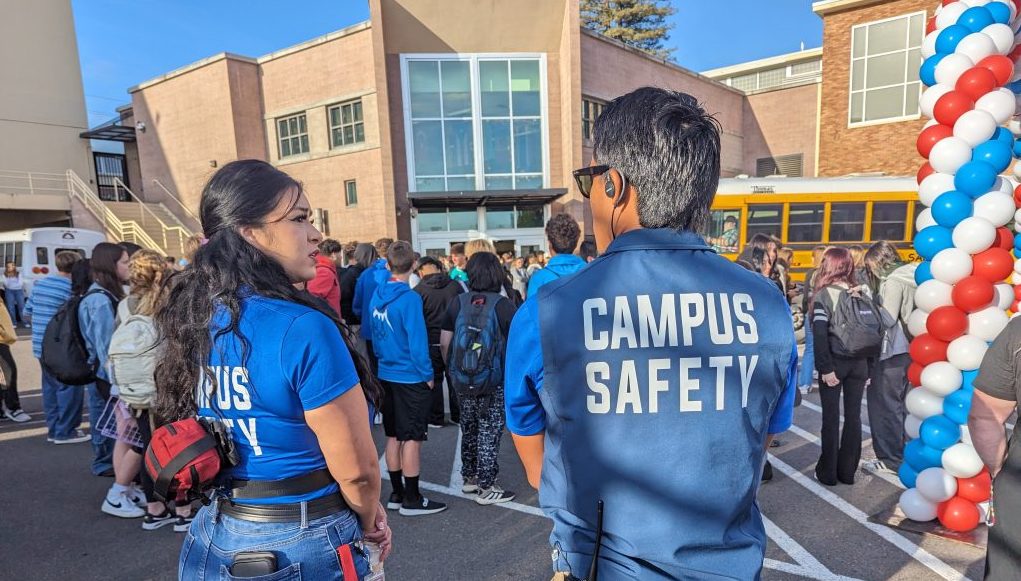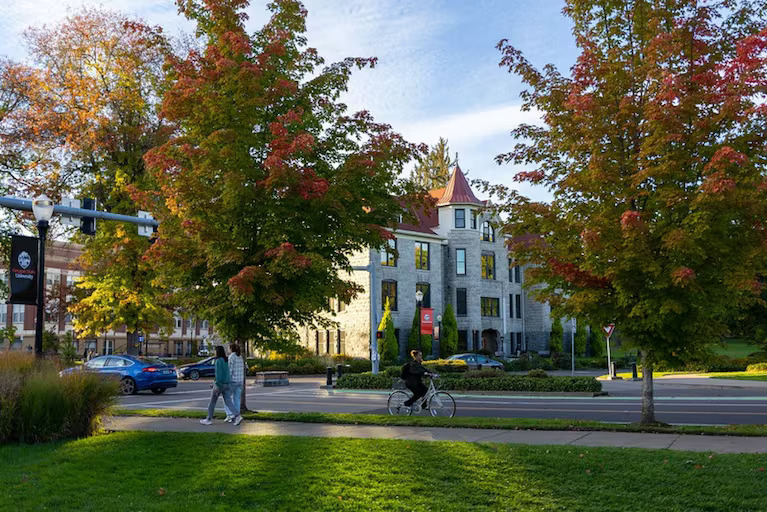Schools need community help to engage youth, prevent gun violence

Salem schools need more community support to intervene with students to cut gang involvement and gun violence, district leaders say.
Psychologists and security leaders with the Salem-Keizer School District said a landmark Nov. 15 report on gun violence in Salem echoes what they see in the halls of local schools, where personal disagreements between a small number of students involved in gangs produce fights and conflict.
“The situation is getting worse in the community because we’re just seeing the same things perpetuate,” said Courtenay McCarthy, a school psychologist who chairs the Mid-Valley Threat Assessment Team. “We have more kids involved … It’s just multiplying because of the number of kids that are involved and getting friends involved.”
Addressing the problem will take mentorship, community programs, mental health counseling and intensive one-on-one work to deter kids and teens who are involved in gangs or contemplating joining. While schools have a role in that work, district leaders said solving the issue requires a community effort and more money for programs and people to work with youth.
Salem last year recorded 20 shootings of people, four of them fatal. One in five victims and suspects were teens 17 and younger, the report said, and the number of teens arrested for serious assaults has tripled in the past three years.
Shootings haven’t come onto school campuses. But lower-level conflict, like fights, as well as kids bringing guns to school disrupt learning for thousands of kids and have contributed to burnout of teachers. They have made safety a major focus during the current contract negotiations.
Far-reaching impacts at school
Chris Baldridge, school district director of safety and risk management, said a handful of students cause most of the conflict. Fights aren’t outright conflicts between gangs, he said. More typically, they begin as personal arguments over things like romantic partners, then escalate into groups throwing punches.
“That small subset is extremely impactful on our schools. We see a great deal of disruption because of this activity and fear amongst our students and staff,” he said.
Educators and school security workers are in regular communication with law enforcement and community partners, meeting monthly to discuss high-risk students and how schools can help them.
The impact of violence and gangs on kids is far-reaching and growing, with schools spending significant resources to prevent and respond to gang involvement and violence.
That includes a network of 45 campus safety workers, most hired after students returned to schools after the pandemic. The team is a diverse group, many of them young Salem-Keizer graduates, who can walk through the halls and easily build rapport with students.
“That’s our greatest asset to preventing violence within our schools is to have a relationship with a kid so that they’ll tell you things so that you can get on the front end of it and help them,” Baldridge said.
Schools also have behavior specialists who engage with kids acting out at school, as well as social workers and other specialists to work directly with struggling students.
One security worker, Ken Ramirez, shifted into a new role last spring reaching out to students one-on-one who are involved in gangs.
Ramirez rides a motorcycle and uses a combination of a wide smile and friendly needling to pry information from monosyllabic teenagers – a skill he employed in his former role as a graduation coach for the district’s Pacific Islander students.
“We knew we needed to do something and we knew we had the right person,” Balridge said.
At South Salem High School, counselor Dwight Roberson began a new role this year. Rather than helping with student schedule changes and mental health concerns, Roberson works directly with students struggling with behavior at school, including those returning to South from suspensions.
Kids land in his office for a range of issues, but Roberson said many are involved in gangs or have relatives who are. His goal is to show them people at school care about them and make sure they feel welcome and supported at South.
“We listen to them and we also try to guide them back into the classroom, but sometimes that’s really hard,” he said.
Shootings or gang violence off campus have a significant impact on those students. Roberson often gets students referred to him following violence in the community.
“They don’t know what they’re feeling, they’re feeling a lot of emotions and mostly they’re like, ‘I don’t want to be at school but I know I have to be at school,’” he said.
The gun violence report highlighted the 2021 departure of school resource officers, who were previously assigned to high schools, as a challenge to sharing information effectively between schools and law enforcement. But Baldridge, a former lieutenant with the Marion County Sheriff’s Office, said that’s not his experience.
He and other members of the security team are available 24/7 to talk to law enforcement and regularly share useful information, like if a student that police arrest outside of school mentions hearing something about a plan for violence at school. If an issue arises, Baldridge knows who to call and police typically respond to school campuses within minutes.
Baldridge said those close connections let school security react quickly to prevent many incidents on campus.
“Those relationships, they’re alive, they’re well,” he said.
Pandemic isolation, youth recruitment
The Covid pandemic and resulting school closures worsened the problem of teen involvement in gangs and resulting gun violence, according to the report.
“Young people lacked the engagement, supervision, and mentorship otherwise provided in the school environment,” the report said.
Kids were often isolated, worsening their mental health, and many dealt with other traumatic events like parents losing a job, or someone they know dying of Covid.
Disengaged kids made easier targets to recruit into gangs.
“Where there is an absence of connection, there is an absence of belonging, people will gravitate toward spaces where they can find some affiliation and connection,” said Chris Moore, the district’s director of social-emotional learning and mental health.
Some people who researchers interviewed about gun violence in Salem reported adults took advantage of the fact that kids would not be as harshly punished for possessing guns and other crimes.
McCarthy, the school psychologist, said the district assesses kids for risk if they’re arrested in the community with a gun. The number of such assessments has grown over the past five years.
Kids can become easy targets for adults involved in gangs when they’re not well-supervised, she said, as when parents work long hours.
And recruiting for gangs can start in elementary school – sometimes because adults reach out to kids to recruit them, but also because younger students have teenage relatives or friends involved in gangs.
Elementary schoolers aren’t necessarily being asked to engage in violence, but some will out of loyalty to the gang or group. Recently, Baldridge said a third-grade student started a fight in school because they felt another student disrespected them.
“It breaks my heart,” he said, his voice heavy with emotion.
Baldridge said his staff try to talk to families and seek their help in keeping kids out of gangs.
“Even when we talk to those families that are gang involved, the one consistent thing we hear is ‘I don’t want my child involved, I don’t want my child involved,’” he said.
But schools need more community help to mentor, engage and intervene with kids who are involved in gangs or at risk for involvement.
McCarthy said Salem needs more adolescent mental health providers to work with at-risk kids.
A number of nonprofits work directly with teenagers, but Baldridge said more is needed. That could be basketball programs, a rap studio, programs focused on street art or a low-rider car club, “something that kids really enjoy,” he said.
Schools could provide space for such activities.
“We have the facility, we just don’t have the staffing to put into the program,” he said. That’s especially true as the district faces deep budget cuts in 2024, with Superintendent Andrea Castañeda saying hundreds of employees will be laid off.
Baldridge said he welcomed Mayor Chris Hoy’s call last week for community leaders to meet and discuss how they can work on the problem, though City Councilor Jose Gonzalez noted many of the organizations doing such work are stretched thin as it is.
“We’re open to hearing ideas from the community on how we can assist,” Baldridge said.
Contact reporter Rachel Alexander: [email protected] or 503-575-1241.
SUPPORT OUR WORK – We depend on subscribers for resources to report on Salem with care and depth, fairness and accuracy. Subscribe today to get our daily newsletters and more. Click I want to subscribe!

Rachel Alexander is Salem Reporter’s managing editor. She joined Salem Reporter when it was founded in 2018 and covers education, economic development and a little bit of everything else. She’s been a journalist in Oregon and Washington for a decade and is a past president of Oregon's Society of Professional Journalists chapter. Outside of work, you can often find her gardening or with her nose buried in a book.



